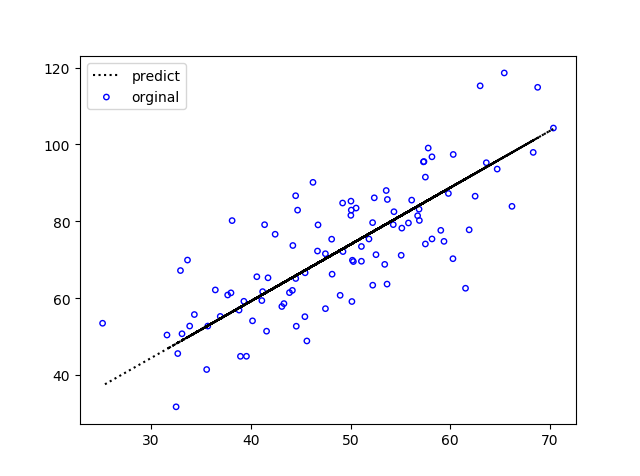一、基本公式
理想的函数:
存在噪音:
优化函数转化为:
更新超参数
二、代码
import numpy as np import matplotlib.pyplot as plt class LineRegression(): def __init__(self): pass def compute_error_for_line_given_points(self, b, w, points): """计算给定超参数【W, B】的误差""" totleError = 0 for i in range(0, len(points)): x = points[i, 0] y = points[i, 1] totleError = totleError + (y-(w*x + b))**2 return totleError/float(len(points)) def step_gradient(self, b, w, points, lr): """梯度下降法更新w,b的值""" b_gradient = 0 w_gradient = 0 N = float(len(points)) for i in range(len(points)): x = points[i, 0] y = points[i, 1] b_gradient = b_gradient - 2*(y-(w*x+b)) / N w_gradient = w_gradient - 2*x*(y-(w*x+b)) / N b_new = b - (lr * b_gradient) w_new = w - (lr * w_gradient) return [b_new, w_new] def gradient_descent_runner(self, points, b, w, lr, iterations): """梯度下降""" for i in range(iterations): b, w = self.step_gradient(b, w, np.array(points), lr) return [b,w] def run(self): points = np.genfromtxt("data.csv", delimiter=",") lr = 0.0001 initial_b = 0 initial_w = 0 iterations = 1000 print( f"Starting project descent at b = {initial_b}, w = {initial_w},error = {self.compute_error_for_line_given_points(initial_b, initial_w, points)}") print(' Running...') [b,w] = self.gradient_descent_runner(points,initial_b,initial_w,lr,iterations) print(f" After project descent at b = {b}, w = {w},error = {self.compute_error_for_line_given_points(b,w,points)}") print(' b:{},w:{}'.format(b, w)) x = points[:, 0] y = w * x + b plt.scatter(points[:, 0], points[:, 1], c='', edgecolors='b', s=15, label='orginal') plt.plot(x, y, c='black', label='predict', linestyle=':') plt.legend() plt.show() if __name__ == '__main__': LineRegression().run()
三、画图
